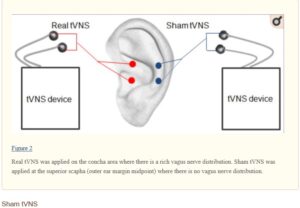TAVNS for Mild Cognitive Impairment Double Blind Study
Kristen Sparrow • May 22, 2023

A double blind randomized trial of transcutaneous auricular vagal nerve stimulation for mild cognitive impairment.
 Scroll down for a brief video explaining the importance of this study.
Scroll down for a brief video explaining the importance of this study.
This randomized controlled trial investigated the effects of transcutaneous auricular vagus nerve stimulation (taVNS) on patients with mild cognitive impairment (MCI). The primary outcome measure was the Montreal cognitive assessment-basic (MOCA-B). After 24 weeks of intervention, the taVNS group showed a significant improvement in MOCA-B scores compared to the sham taVNS group. Other secondary outcome measures, including auditory verbal learning, cognitive tests, sleep quality, and functional activities, also showed positive improvements in the taVNS group. The study suggests that taVNS may be an effective and affordable therapy for MCI patients to prevent or delay the progression to dementia, but further research is needed.. I’ve noted other studies on this topic here and here.
https://www.brainstimjrnl.com/article/S1935-861X(22)00207-8/fulltext
Wang L, Zhang J, Guo C, He J, Zhang S, Wang Y, Zhao Y, Li L, Wang J, Hou L, Li S, Wang Y, Hao L, Zhao Y, Wu M, Fang J, Rong P. The efficacy and safety of transcutaneous auricular vagus nerve stimulation in patients with mild cognitive impairment: A double blinded randomized clinical trial. Brain Stimul. 2022 Nov-Dec;15(6):1405-1414. doi: 10.1016/j.brs.2022.09.003. Epub 2022 Sep 21. PMID: 36150665.
Abstract
Background: There are 9.9 million new cases of dementia in the world every year. Short-term conversion rate from mild cognitive impairment (MCI) to dementia is between 20% and 40%, but long-term in 5-10 years ranges from 60% to 100%. It is particularly important to prevent or prolong the development of MCI into dementia. Both auriculotherapy and vagus nerve stimulation are effective on improving cognitive functions. However, there is no double blinded randomized clinical trial to support the effectiveness of transcutaneous electrical stimulation of auricular acupoints in patients with MCI.
Methods: This randomized controlled trial involved patients with MCI, aged from 55 to 75 years old. Patients were randomly allocated to transcutaneous auricular vagus nerve stimulation (taVNS) group or sham taVNS group. In the taVNS group, two auricular acupoints were stimulated, including heart (concha, CO15) and kidney (CO10), which are in the distribution of vagus nerve. While in the sham taVNS group, two other auricular acupoints were stimulated, including elbow (scaphoid fossa, SF3) and shoulder (SF4,5), which are out of the distribution of vagus nerve. The primary outcome was the Montreal cognitive assessment-basic, MOCA-B. The secondary outcomes included auditory verbal learning test-HuaShan version (AVLT-H), shape trails test A&B (STT-A&B), animal fluence test (AFT), Boston naming test (BNT), Pittsburgh sleep quality index (PSQI), rapid eye movement sleep behavior disorder screening questionnaire (RBDSQ), Epworth sleepiness scale (ESS) and functional activities questionnaire (FAQ). These outcome measures were taken at baseline, 24 weeks later.
Results: After 24 weeks of intervention, the data of 52 patients were intended for analysis. After intervention, there was significant difference in the overall scores of MoCA-B between taVNS group and sham taVNS group (p = 0.033 < 0.05). In taVNS group, compared with before intervention, the overall scores of MOCA-B increased significantly after intervention (p < 0.001). As for N5 and N7, the two sub-indicators of AVLT-H, in taVNS group, compared with before intervention, both N5 and N7 increased significantly after intervention (both ps < 0.001). As for STTB, in taVNS group, compared with before intervention, STTB was significantly reduced after intervention (p = 0.016). For BNT, in taVNS group, compared with before intervention, BNT increased significantly after intervention (p < 0.001). In taVNS group, compared with before intervention, PSQI, RBDSQ, ESS and FAQ decreased significantly after intervention (p = 0.002, 0.025, <0.001, 0.006 respectively). 1 patient with a history of tympanic membrane perforation in taVNS group was reported with mild adverse reactions which disappeared a week after termination of taVNS. The intervention of taVNS is effective on increasing the overall scores of MoCA-B, N5 and N7.
Conclusion: The clinical trial demonstrated that taVNS can improve cognitive performance in patients with MCI. This inexpensive, effective and innovative method can be recommended as a therapy for more patients with MCI in the prevention or prolonging of its development into dementia, but it is still required to be further investigated.

